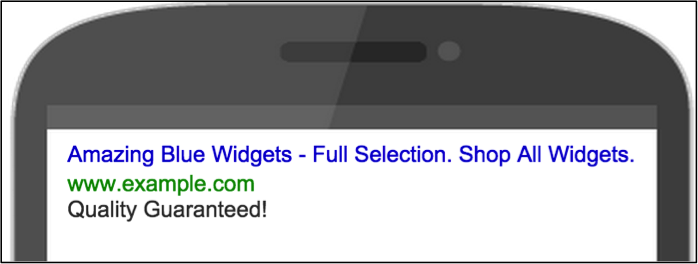Google recently announced that beginning on 10/15, mobile ads have the potential to show your ad extensions instead of description line two. Our own Kevin Klein wrote a piece explaining how this update will impact mobile ad creation moving forward. We now want to look at this update in the context of overall mobile strategy.
Gone are the days where mobile PPC is an afterthought. It doesn’t have to be a large portion of your strategy, but it does need to be addressed. Whether you aggressively target mobile users, set bid modifiers of -80%, or only allow visitors to call, mobile is part of the PPC game. Now that ad extensions have the potential to replace description line two, your copy needs to better flow within the real estate of your ads.
Thinking Holistically
Mobile ads need to be more concise as the attention span of a mobile user is shorter. We see this rationale with mobile websites as they tend to be trimmed down versions of their desktop counterparts. Thus, it’s often beneficial to make sure description lines one and two combined are no more than 60 characters. Less characters means a more concise message (and avoids possible ad truncation). Additionally, utilizing extended headlines (where description line one ends with a period) allows for more appealing ads.
At least one ad in every ad group should utilize an extended headline where description line one contains the call to action. Here’s an example of an ad that uses this criteria.
Description line one speaks to the widget selection while also containing a call to action. If description line two is removed in favor of an ad extension(s), we’ll lose the messaging “quality guaranteed,” but we still make our pitch in the first line. Our ad is still concise while telling users what action to take.
Mobile Specific Ad Extensions
Ad extensions are the second part of the equation. Just like desktop, mobile ads need to use ad extensions. These extensions should be specifically crafted for mobile. For example, a mobile sitelink may say “Loyalty Club” where the desktop version might say “Join Our Loyalty Club.” Or, by utilizing the call extension, users can reach the company directly by tapping the “Call” button. Other mobile specific extensions may include:
- App extensions
- Callout extensions
- Location extensions
Though description line two will always be necessary when writing ads, extensions can make up for this missing line. Ads will be more likely to now offer a selection of choices vs. the standard headline and two description lines. You may ask how this scenario is different from before. From a technical standpoint, there will be one less line of non-clickable text, but from an aesthetics review, ads have the potential to flow more fluidly (assuming there is thought behind description line one and ad extensions). There will be a boutique of easy to click choices.
It’s also important to note that ad extensions should be used because they now factor into the quality score algorithm. If you are thinking of avoiding this update, think again. Your ad extensions play a role in your ad rank and ultimately your mobile success.
Conclusion
At the end of the day, this update won’t make or break mobile performance, but it will help to solidify your ad presence against the competition. Cleaner, more precise ads will draw eyeballs and ultimately clicks.




